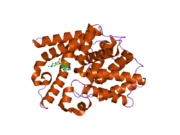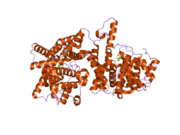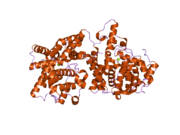PDE10A
cAMP and cAMP-inhibited cGMP 3',5'-cyclic phosphodiesterase 10A is an enzyme that in humans is encoded by the PDE10A gene.[5][6]
Various cellular responses are regulated by the second messengers cAMP and cGMP. Phosphodiesterases, such as PDE10A, eliminate cAMP- and cGMP-mediated intracellular signaling by hydrolyzing the cyclic nucleotide to the corresponding nucleoside 5-prime monophosphate.[6][7]
Inhibitors

- Compound 96: IC50 = 700 pM, high selectivity against all other members of the PDE family[8]
- Papaverine[9]
- PF-2545920[10]
- TAK-063: IC50 = 300 pM[11]
- AMG 579[12]
Research
Preliminary evidence indicates a possible link between PDE10A expression and obesity in mice and humans.[13]
References
- ^ a b c GRCh38: Ensembl release 89: ENSG00000112541 – Ensembl, May 2017
- ^ a b c GRCm38: Ensembl release 89: ENSMUSG00000023868 – Ensembl, May 2017
- ^ "Human PubMed Reference:". National Center for Biotechnology Information, U.S. National Library of Medicine.
- ^ "Mouse PubMed Reference:". National Center for Biotechnology Information, U.S. National Library of Medicine.
- ^ Fujishige K, Kotera J, Michibata H, Yuasa K, Takebayashi S, Okumura K, Omori K (Jul 1999). "Cloning and characterization of a novel human phosphodiesterase that hydrolyzes both cAMP and cGMP (PDE10A)". J Biol Chem. 274 (26): 18438–45. doi:10.1074/jbc.274.26.18438. PMID 10373451.
{{cite journal}}: CS1 maint: unflagged free DOI (link) - ^ a b "Entrez Gene: PDE10A phosphodiesterase 10A".
- ^ Fujishige K, Kotera J, Yuasa K, Omori K (October 2000). "The human phosphodiesterase PDE10A gene genomic organization and evolutionary relatedness with other PDEs containing GAF domains". Eur. J. Biochem. 267 (19): 5943–51. doi:10.1046/j.1432-1327.2000.01661.x. PMID 10998054.
- ^ a b Malamas, MS; et al. (2011). "Highly potent, selective, and orally active phosphodiesterase 10A inhibitors". J. Med. Chem. 54 (21): 7621–38. doi:10.1021/jm2009138. PMID 21988093.
- ^ Siuciak JA, Chapin DS, Harms JF, et al. (August 2006). "Inhibition of the striatum-enriched phosphodiesterase PDE10A: a novel approach to the treatment of psychosis". Neuropharmacology. 51 (2): 386–96. doi:10.1016/j.neuropharm.2006.04.013. PMID 16780899.
- ^ Verhoest PR, Chapin DS, Corman M, et al. (August 2009). "Discovery of a novel class of phosphodiesterase 10A inhibitors and identification of clinical candidate 2-[4-(1-methyl-4-pyridin-4-yl-1H-pyrazol-3-yl)-phenoxymethyl]-quinoline (PF-2545920) for the treatment of schizophrenia". J. Med. Chem. 52 (16): 5188–96. doi:10.1021/jm900521k. PMID 19630403.
- ^ Kunitomo J, Yoshikawa M, Fushimi M, et al. (2014). "Discovery of 1-[2-Fluoro-4-(1H-pyrazol-1-yl)phenyl]-5-methoxy-3-(1-phenyl-1H-pyrazol-5-yl)pyridazin-4(1H)-one (TAK-063), a Highly Potent, Selective, and Orally Active Phosphodiesterase 10A (PDE10A) Inhibitor". J. Med. Chem. 57 (22): 9627–43. doi:10.1021/jm5013648. PMID 25384088.
- ^ Hu; et al. (2014). "Discovery of Clinical Candidate 1-(4-(3-(4-(1Hbenzo[d]imidazole-2-carbonyl)phenoxy)pyrazin-2-yl)piperidin-1-yl)ethanone (AMG 579), a Potent, Selective, and Efficacious Inhibitor of Phosphodiesterase 10A (PDE10A)"". J Med Chem.
- ^ Hankir, Mohammed K; et al. (2016). "A novel thermoregulatory role for PDE10A in mouse and human adipocytes". EMBO Molecular Medicine.
Further reading
This article incorporates text from the United States National Library of Medicine, which is in the public domain.



















